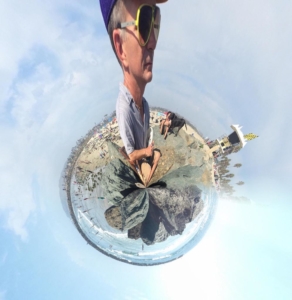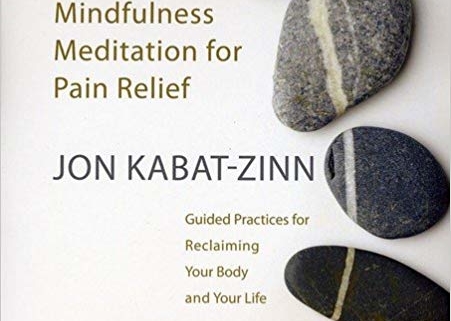Mindful meditation for pain relief
Meditation and mindfulness reduce suffering from pain. The United States Veterans Administration advocates mindful awareness, a process each person must follow until finding what works for their unique situation. Many books and online resources are available to help your process; here’s what worked for me, I hope it helps you.
I had postponed surgery for painful conditions and spent several years trying alternative treatments, ranging from ibuprofen for pain and inflammation, opioids that numbed my mind, physical therapy, acupuncture, chiropractic therapy, diet changes, etc. Before trying meditation I researched fact-based studies rather than anecdotal accounts, and the fact is that some people have found relief from suffering through meditation for thousands of years and research in 2019 showed that brain neurons that allow mice to feel pain are different than the brain neurons that cause suffering from pain.
In other words, we should be able to detach those neural connections with time and practice because meditation is for the mind what exercise is for the body. You exercise your body to be healthy and obtain goals; meditation is a way to become mindful and detach the neurons of pain from the neurons of suffering from pain.
A photographer can be meditating without knowing it if they are immersed in their work, creating art. A child can be meditating while playing at the beach, experiencing the waves as new experiences. Any activity can lead to relief of suffering if done intentionally and mindfully.
Mediation is a way to facilitate mindfulness by exercising your mind the same way you exercise your body.
The mind is not a part of our body like the brain, it’s the interaction between our senses, perceptions, sensations, and expectations. The mind was famously demonstrated by Pavlov’s dogs; their bodies salivated when they heard a bell because they had been conditioned to expect food after Pavlov rang a bell. The dogs salivated when there was no food, no smells or sights or other senses present, because their minds created associations between sounds, associations, memories, and physical reactions.
We’re like Pavlov’s dogs, but instead of reacting to a bell we are reacting to a sensation, pain, and creating another sensation, suffering. Mindfulness allows us to see our mind when we concentrate on the interactions between our senses, perceptions, sensations, and expectations.
Our minds are difficult to see at first because we become so used to reacting mindlessly, which is why meditation is a useful exercise to become more mindful.
Like with most exercise we’re more likely to practice it daily when it’s fun or when we share the experience with others, such as this photo of me meditating near a lifeguard tower on the beach in San Diego while a friend took photos. He was meditating too, looking for opportunities to use a feature on his phone that wrapped images into a “tiny planet.”

I had been meditating for an hour when my friend took the photo, his form of meditating. We had fun, and I continue to have fun meditating, but at the time of this photo I was not practicing effective meditation. I was relaxed, focused on the moment and enjoying the process, but my methods did not facilitate long-term mindfulness. It would take me another year to learn more effective meditation techniques. Here’s my advice to learn effective meditation:
- Meditate for three minutes each day. Don’t worry. You can’t do it incorrectly, meditation begins with an intention to learn.
- Sit comfortably and quietly and observe your breathing without controlling it.After a few breaths observe your posture and ensure your back and neck are straight but naturally curved.
- Your chin will likely come toward your chest; allow it.
- Observe if your muscles are tense or relaxed without trying to control them.Observe your breath again.
- Be aware when your attention or thoughts drift. Don’t judge or try to control your attention or thoughts, just be aware and observe them naturally returning to the object of your meditation.
- Be aware when you are simultaneously aware of your breath, posture, and relaxation.
- Eventually, practice walking meditation, simply going for a walk while meditating. Practice talking meditation, simply talking with people while observing your mind. Then practice mindful meditation with situations that used to cause feelings of suffering, irritation, annoyance, worry, anger, anxiety, or any other unwholesome mental state.
- Continuously reassess your progress without adding worry or anxiety: sometimes you’ll do well, sometimes you’ll falter, sometime
s you’ll forget how far you’ve come. - Have fun. Discuss progress with friends. Learn. Improve.
Most of my progress in eliminating suffering from pain came in a single moment, as fast as it takes to bite through a candy bar. I had practiced mindful meditation while hiking in the Himalaya Mountains for a month; my practice was partially out of necessity, I was suffering from altitude sickness, distracted by physical discomfort in my back and neck, and concerned that pain in my ankle could be metal medical implants eroding bones.

Here’s what I wrote about that experience in another article, using a metaphor of piloting a bus to illustrate the link between your mind, body, awareness, and choices:
You’re the pilot of a bus that represents your body and passengers that represent your thoughts. The road and other drivers are external situations often out of your control. Sometimes your bus isn’t in perfect condition, you may have deflated tires or weak shock absorbers, but you must pilot it over any road condition while listening to your passengers.
Your passengers are like kids on a bus, sometimes joyful, sometimes crying, and always there. Your passengers constantly remind you about your deflated tires, weak shock absorbers, pain in your ankle, pain in your neck, etc. The passengers yell loudly and warn you to look out for other buses; they may whisper to you when worried about where you’re going, talk about where you’ve been, ask about a work project that’s not finished, wonder what other people are doing, or talk about other aspects of your life not relevant to the immediate situation of piloting your bus.
But, you can’t ignore all passengers because some are telling you when to rest or paying attention to your headache, ensuring it’s not a symptom of life-threatening altitude sickness. Some passengers let you know about slippery ice on the road or a possible avalanche because of snow conditions. They may notice something about other drivers that needs your attention, including if that person needs help.
For several weeks I concentrated on piloting a bus, the essence of mindful meditation, and in one moment realized many of these things in ways that weren’t expressed as words or thoughts at the time, they were insights seen at a deep level that happens faster and deeper than words or thoughts can be formed by our brains. I understand many things now that became clear in a single moment that lasted the time it takes to bite through a peanut in a Snickers candy bar. That’s literally when I saw what was going on: I had just summited one of the world’s highest mountain passes after several weeks of mindful meditation when I saw someone unconscious from altitude sickness. A few of us kept them safe and arranged a helicopter evacuation. Afterwards, I was alone with a few more hours of hiking downhill before the next village.
I had been so focused on the rescue that I hadn’t felt pain or symptoms of altitude sickness. I started to notice the pain again, and was weak from a combination of physical and emotional exhaustion, lack of sleep, lack of food, and altitude sickness. I stopped to eat a Snickers bar, the first food I had been able to eat in two days. I sat cross-legged, planning to meditate, but was so tired that even meditating seemed like too much work so I focused on enjoying the Snickers. My teeth sank into the outer layer of chocolate with alternating textures of hard from the cold and soft from the heat of my hand, into the gooey layer of sweet caramel nugget, and into the hard outside of a salty peanut. I’m not exagerating when I say that my life changed in the time it took to complete biting through that peanut.
I still do formal meditation each day for 5 to 15 minutes, but most of my meditation comes from mindfulness while doing other things. My rate of progress comes and goes, but overall I’m happier and more centered than a year ago before I learned to practice more effectively.
I’m currently working on the next steps of mindful meditation, cultivating compassion and loving kindness by being aware when they are present and aware when they are not present. I’ve also been reading books on meditation techniques, and realized that for me it’s difficult to be aware of feelings or sensations that are neither pleasant nor unpleasant; we react to pleasant or unpleasant feelings with attachment or aversion, craving more of the pleasant and desiring to end the unpleasant, but are not trained to recognize neither pleasant nor unpleasant sensations or feelings. I’m becoming aware of that limitation.
What continues to make meditation fun for me is the freedom to practice it around my friends and loved ones. It became a game, something to share with people while they were meditating on photography, surfing, or playing with their kids in the waves.
What’s continued to surprise me is how much of my journey was documented in ways I didn’t understand at the time, and represents what humans have always sought: to be happy. 2,600 years ago The Buddha, who taught that Right Mindfulness was part of the path to eliminating suffering, gave practical advice during one of his first teachings:

